- Originally Published: February 28, 2019
- No Comments
- Jillian Smith, RD, Bianca Gruenewald, RD & Mallory Roberts, SLP
- Updated: February 3, 2025
Rice is a cereal grain that originated in Asia and has been an important part of the diet of many cultures for centuries.
Today, rice is a common first food introduced to babies all around the world, with traditional dishes including Xifan and Khao Rom.
That said, its sticky texture and loose grains can make this food more challenging for some babies to handle and can cause gagging, leaving parents unsure of how to serve it and when it’s safe to do so.
Don’t worry—we’ll give you all the information you need to know!
Table of Contents
When can babies have rice?
Rice is safe for babies to eat around 6 months of age when they’re showing all of the developmental signs of readiness to start solids.

Rice is a great food to offer to your baby because it provides a unique grainy texture that’s beneficial for developing your baby’s oral motor skills and for preventing picky eating down the road.
How to serve rice according to the Texture Timeline™

These are the safest, suggested ways to serve food to your baby based on the scientific, developmental, and clinical research and expertise available to date and are vetted by pediatric doctors, speech-language pathologists, and dietitians. However, please note that babies can technically choke on anything, including purees. Always take into account your child’s individual abilities and needs and check with your doctor or feeding therapist on the safety of offering these foods to your baby. Be mindful of how to set up a safe eating environment and please know that all material, opinions, advice, and information found on mylittleeater.com is for informational and educational purposes only. See our disclaimer for more information.
What is the Texture Timeline™?
A tool exclusive to My Little Eater that allows you to start solids with your baby using purées, finger foods, or a mixture of both. We sort all foods into different phases of the timeline based on texture difficulty, presenting multiple ways to serve each food depending on what you and your baby are ready for.
You can start with any phase of the Texture Timeline™. The goal is to always be moving forward on the timeline so that you can advance your baby to more challenging textures in a timely manner. This will allow your baby to develop and practice new eating skills and ensure that they don’t stay stuck on one texture for too long.
Using the Texture Timeline™ can help to prevent picky eating, all while keeping the feeding process enjoyable and less stressful for you because you can ease into the difficult textures that often cause more anxiety and worry.
Texture Timeline™ Phase 0
Thin puree, rice cereal (Utensil)

Add cooked rice to a blender along with a bit of water, breastmilk, or formula. Blend until a thin, smooth puree is achieved.
Serve on a preloaded spoon for your baby to practice using utensils. If your baby isn’t interested in using utensils right away, let them dig in with their hands!
Texture Timeline™ Phase 1
Blended (Utensil)

Add cooked rice to a blender and blend until a thick purée forms (aim for the texture of hummus). Add water, breastmilk, or formula as needed to help with the blending process.
Serve on a preloaded spoon for your baby to practice using utensils. Or, if they’re not interested in using utensils right away, let them dig in with their hands!
Texture Timeline™ Phase 2
Mixed into a puree (Utensil)

You can mix cooked rice into a binding puree like hummus, yogurt, or mashed potatoes. This will add moisture and keep all the little pieces of rice bound together, making it easier for your baby to manipulate in their mouth, chew, and swallow.
Serve the mixture on a preloaded spoon for your baby to practice using utensils. If your baby isn’t interested in using a preloaded spoon yet, you can let them dig in with their hands!
Texture Timeline™ Phase 2
Rolled into a ball (Palmar grasp)

Roll 2-3 tbsp of cooked rice into a ball. Calrose or sushi rice is best for this method, as it will be sticky and can be formed into an easy-to-mold shape after cooking and letting it cool down.
Serve this to your baby for them to pick up and hold using their palmar grasp.
Texture Timeline™ Phase 2
Mixed into a puree, rolled into a ball (Palmar grasp)

Top tip!
Top tip!
You can roll the rice ball in nutritional yeast, seaweed pieces, ground nuts, or hemp seeds for added nutrition and a different texture experience.
It can also provide some grip if the rice and puree mixture is slippery.

Texture Timeline™ Phase 3
Loose grains (utensil/Pincer grasp)

To offer your baby a very loose, grainy, and advanced texture, cook rice and serve it as is on a preloaded spoon. This will provide your baby with great practice in learning how to manipulate many small particles in their mouth at once.
If your baby isn’t interested in eating from a spoon, dump a small pile of cooked rice onto their tray and let them dig in with their hands! Once your baby develops their pincer grasp, they can practice picking up the rice on the tray with their fingers.
Top tip!
Top tip!
Different types of rice will provide different texture experiences for your baby! For example, cooked wild rice provides a much chewier and more advanced texture than sticky, parboiled, white, jasmine, or basmati rice.
Once your baby has practiced with white rice and becomes more experienced, you can experiment with serving well-cooked wild rice.

Watch these sweet babies eat rice!
Watch these sweet babies eat rice!
Baby Brinley is 9 months old and is enjoying our Chicken Curry Rice Cups.
Baby Destiny is 10 months old and is eating rice that has been rolled into a ball.
Baby Brinley is 9 months old and is enjoying our Chicken Curry Rice Cups.
Baby Destiny is 10 months old and is eating rice that has been rolled into a ball.
Is rice a choking hazard for babies?
No, rice isn’t considered to be a high-risk choking hazard for babies.
That said, the Centers for Disease Control and Prevention claims rice is a choking hazard for babies who are under 12 months old (3). While grains of rice are significantly smaller than a baby’s airway making it difficult for them to cause a complete blockage (ie. choking), we don’t eat rice one grain at a time.
There’s always a risk of choking (even with purees) so while rice isn’t considered a high-risk choking hazard, it isn’t impossible, and safe serving techniques should be followed.

It’s also important to note that there are certain rice recipes, such as mochi, that are not safe for babies. Mochi is one example where steamed, sticky rice is mashed and pounded together to make dense balls or cakes.
This dish is a known choking hazard due to its sticky and chewy consistency (4). Mochi should not be served to your baby or young child.
Another important thing to keep in mind is that gagging is common when babies eat rice. The small grains can scatter in your baby’s mouth, making it difficult for them to manage, which often results in gagging.
But – gagging and choking are very different, and gagging does not cause choking to occur. In fact, it helps prevent it. Binding the grains with hummus or yogurt can make it easier for your baby to manage and swallow and can reduce gagging as well.

If you’re concerned about the severity of your baby’s gagging, read more about excessive gagging to find out when further evaluation is necessary.
Can babies digest starches like rice?
Yes, babies can digest rice.
You may have heard some concerns about a baby’s ability to digest starchy foods like rice, bread, potatoes, oatmeal, etc. There are a lot of blogs out there that spread misinformation and cause fear that babies can’t handle starch.
This opinion isn’t based on research and is not accurate.
Babies are in fact capable of digesting starch at around 6 months when they’re showing all of the developmental signs of readiness to start solid foods.
Avoiding starchy foods greatly limits the variety of foods available for your baby to eat. Even bananas contain starch!
That is why we recommend that you ignore this misinformation and include starchy foods in your baby’s diet as part of the well-balanced, variety of solid foods you offer.

Fun fact
Fun fact
Rice is a grain or cereal, just like wheat or oats. A grain is the whole seed of a plant that is grown, harvested, and processed for consumption (1). Rice is the seed harvested from the long grass-like stalk of the Oryza sativa plant (Asian rice) or the Oryza glaberrima plant (African rice) (1).
While both types of rice are grown in North America today, Oryza sativa is the more commonly grown plant (2). However, you probably won’t be able to tell the two types of rice apart as there are only slight differences in their appearance (1).
Arsenic in rice & rice products
Based on the research, there is concern with the amount of inorganic arsenic (a known neurotoxin and carcinogen) present in some foods for babies and young children.
Rice, infant rice cereals, and rice-based products in particular have been found to have higher levels of inorganic arsenic.
To limit the amount of arsenic exposure, rice, rice cereal, and rice-based products shouldn’t make up the majority of your baby’s diet and shouldn’t be offered daily.

Offer a variety of foods, flavors, and textures to your baby, including other grains such as barley, oat, and quinoa which are lower in arsenic. We also suggest serving your baby varieties of rice that are lower in arsenic more often than other varieties.
Read more about our recommendations on arsenic in rice and other foods for your baby.
Best rice for babies
There are over 120,000 varieties of rice worldwide, which can be quite overwhelming when trying to find the best option for your baby (5).
When determining the best rice for your baby, there are three main factors to look at:
- Texture
- Nutrition
- Arsenic levels

Texture
The texture of each rice type varies. Some grains are chewier, some are softer, and some are more sticky. In reality, all rice varieties are safe for babies once they show all of the developmental signs of readiness to start solids at around 6 months of age.
View the image below to compare the different textures of rice (6).

If your baby is just starting solids and you’re a bit cautious, you can offer your baby sticky, parboiled, white, jasmine, or basmati rice which are softer in texture (and generally have less arsenic than other varieties).
Once your baby is more experienced, you can offer a wider variety of rice types including well-cooked wild rice and brown rice which are chewier and more dense.
Nutrition
The nutrients in rice vary depending on the type of rice.
Generally, brown rice is more nutritious than white rice because many nutrients are stored in the outer bran layer of rice, which is removed to make white rice.
Brown rice is higher in fiber, vitamins B1 and B6, magnesium, phosphorus, manganese, and iron.
However, the high fiber content in brown rice can easily fill up a baby’s stomach, leaving little room for other important foods. For this reason, we don’t recommend offering brown rice above and beyond white rice for babies.

For the full breakdown of the nutrients provided and their impact on the body, jump to the nutrition section below.
Arsenic
The arsenic content of rice is also something to consider when choosing the type of rice to offer to your baby. The inorganic arsenic content of rice varies depending on the type of rice and where it was grown (7).
Read this article for a detailed guide on arsenic in rice and other foods for your baby, including which foods are safe to serve and which may have too much arsenic.
Our top choice (based on arsenic levels) for the best rice to serve to your baby is white basmati rice from California. It contains the lowest amount of arsenic (7).

Other good choices are white basmati rice from India and Pakistan and sushi rice from the United States. These have around half of the amount of arsenic compared to other rice varieties (7).
Rice that tends to be the highest in arsenic is all types of rice (except sushi and quick cooking) that indicate they came from Arkansas, Louisiana, or Texas (7). Brown rice from the US is also a concern as it has 80% more inorganic arsenic on average than white rice of the same type (7).
How to cook rice to reduce arsenic levels
Even if you’ve chosen a rice low in arsenic, it’s still important to cook it in a way that can help reduce the levels of inorganic arsenic even further – especially when serving it to babies.
Scientists have found a new and effective method to cook rice that reduces arsenic levels and retains more nutrients (8):
- Add rice to already boiling water (4 cups of water to 1 cup of rice).
- Continue boiling for 5 minutes, and then dump all of the water out.
- Add fresh water (2 cups of water to 1 cup of rice).
- Turn the heat down to medium-low and cover with a lid.
- Continue cooking until all of the water is absorbed by the rice.

We love this option because it removes over 50% of arsenic from brown rice and 74% of arsenic from white rice (8).
Watch this method in action in the video below!
Can you cook rice and store it for later?
Yes! Cooked rice can be stored for later use, although it must be consumed within 24 hours after cooking.
We need to be really careful with food safety when weaning to solid foods, especially with rice. Uncooked rice contains a bacteria called Bacillus cereus which can cause food poisoning if rice is not stored correctly and can make you or your little one very ill (9).
This is especially true for babies and younger children who are at an increased risk of developing food poisoning from bacteria (10).
The longer rice is kept at room temperature, the more unsafe it is to eat (9). If you have leftover rice after cooking it, chill it as quickly as possible. This can be done by dividing the rice into smaller portions. Avoid letting rice cool down in the cooker, steamer, or pot (9).
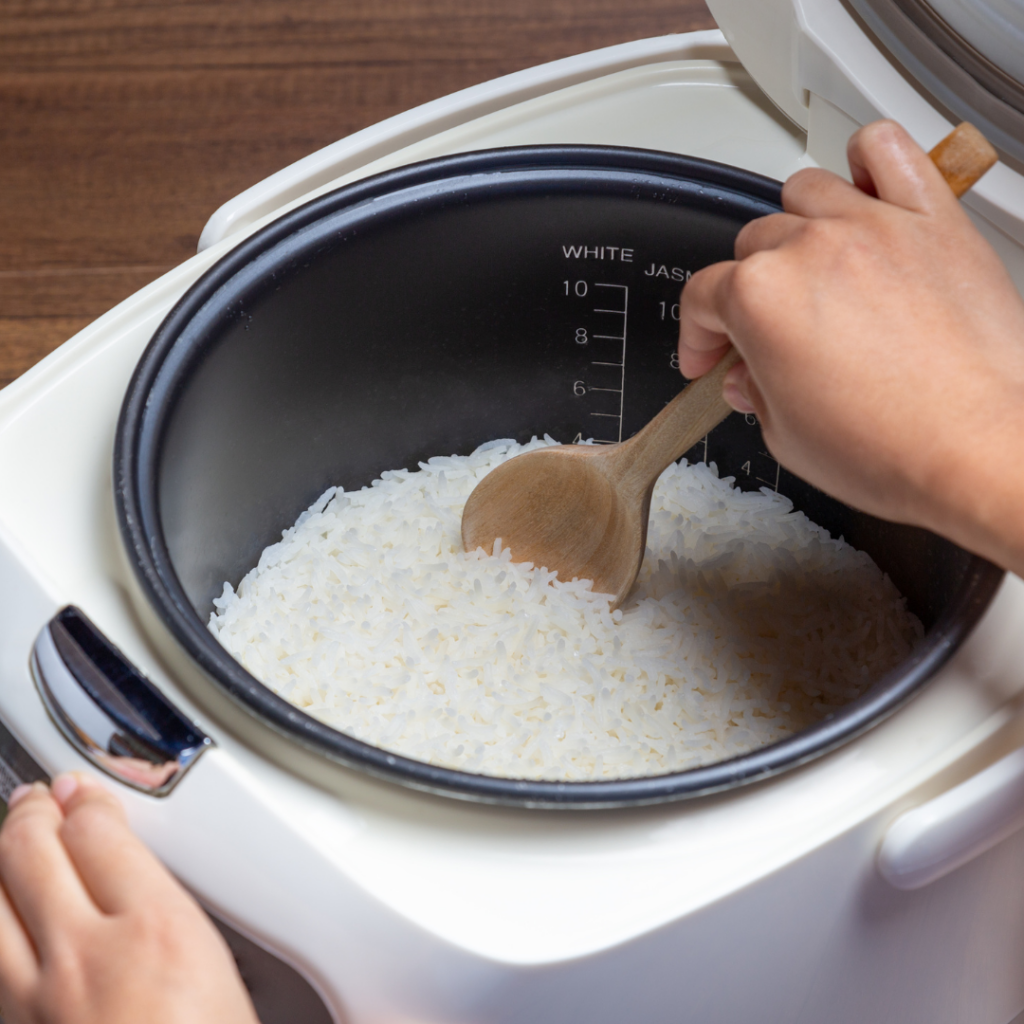
Once the rice has cooled down, you can put it in an airtight container in the fridge to use within 24 hours. When you reheat cooked and cooled rice for another meal, reheat it all the way through, and never reheat it more than once (9).
If you don’t think you’ll be able to use leftovers within that time, you can also store cooked and cooled rice in the freezer for up to 6 months (9, 11). Once you take the rice out of the freezer and thaw it, ensure to reheat it thoroughly and that the texture of the rice has not been altered too much before offering it to your baby.
Rice for babies around the world
Rice has been a staple food for centuries in many different countries all around the world (25). In many cultures, starting solids is often celebrated by offering rice to babies as their first food!
Rice is often paired with protein and/or vegetables along with spices to create a signature dish.
Take a look at the different rice dishes around the world that are offered as a first meal to babies (26, 27, 28)!
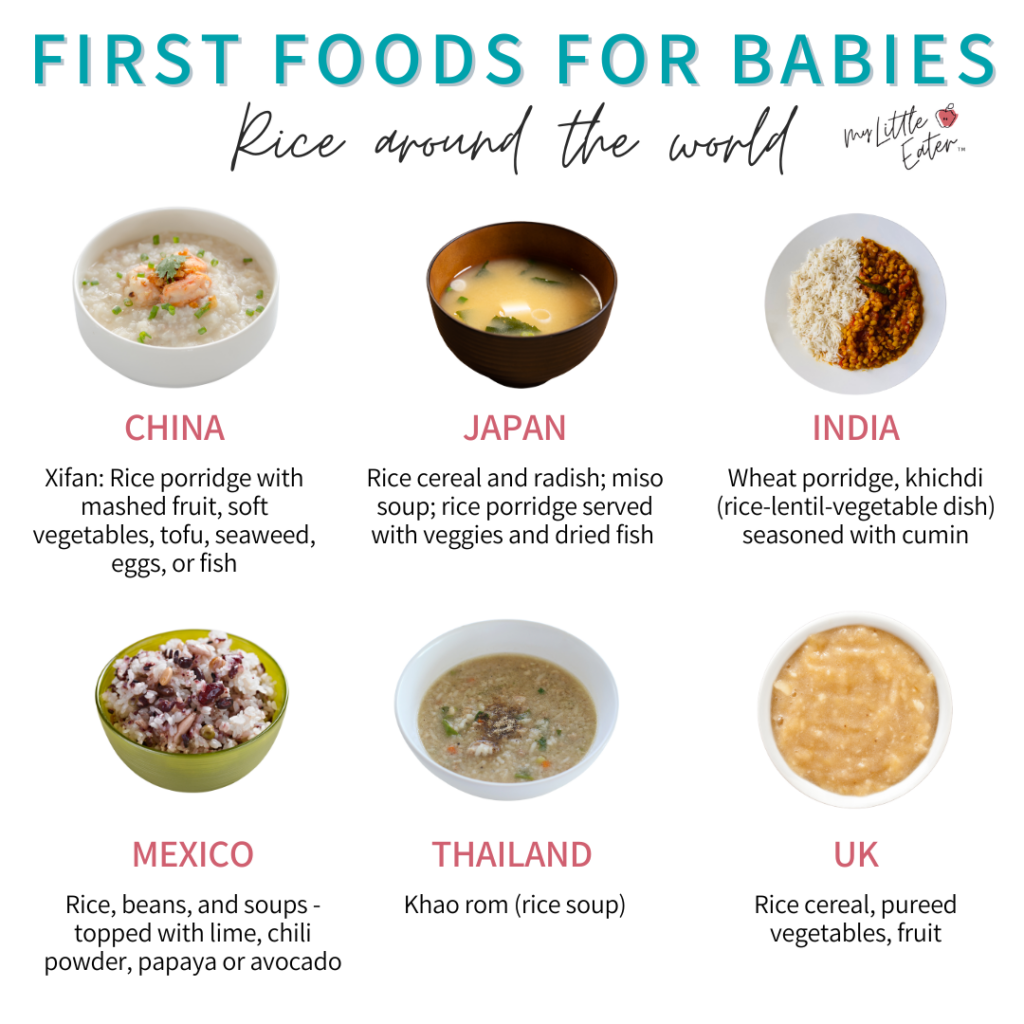
Nutritional benefits of cooked rice
Rice can be a safe and healthy addition to your baby’s diet in moderation and provided that different varieties are offered.
Rice is a good source of carbohydrates (ie. energy) (12). Depending on the variety, it also offers your baby essential nutrients like…
- Fiber: Important for gut health, digestion, controlling blood sugar levels, and providing satiety (13).
- Vitamin B1 (thiamin): This plays a crucial role in turning food into energy in our body and is important for cell growth and function (14).
- Vitamin B6: This has a role in creating antibodies to fight sickness, preventing disease, and promoting brain function (15).
- Magnesium: Regulates muscle and nerve function, blood pressure, and blood sugar levels (16).
- Phosphorus: Important for bone health, bone growth, and muscle function (17).
- Selenium: Protects against cell damage and infections, and is important in reproduction and thyroid health (18).
- Manganese: Important for healthy bones, wound healing, brain health, and inflammation (19).
- Iron: Maintains healthy blood and transports oxygen in the body (20). Iron is essential for the proper growth and development of children (21).
Although rice offers many beneficial nutrients, the amount of nutrients depends on the variety of rice. The above nutritional benefits are primarily for whole grain varieties, such as brown rice.
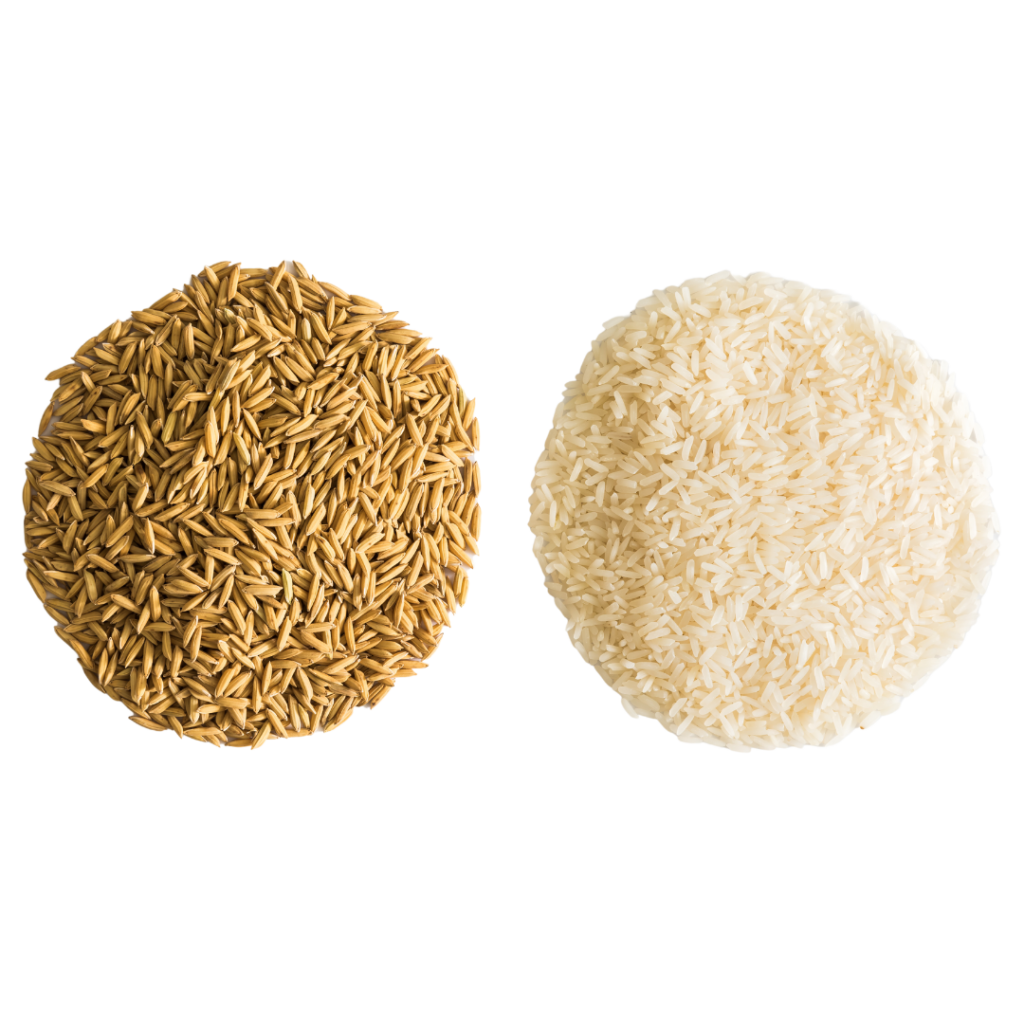
When whole rice has been milled and polished to create white rice, the outer bran layer is removed, taking away many of the vitamins, minerals, and fiber.
The B vitamins and iron are often added back to white rice in a process called fortification. However, only a small portion of the original nutrients are added back to fortified or enriched rice.
Can babies be allergic to rice?
Rice is not one of the top 10 highly allergenic foods and can therefore be introduced alongside other foods without having to wait (the 2-day wait rule is for top allergens only).
Allergies to rice are rare but not impossible! If you suspect your baby or toddler has an allergy, it’s best to consult with your doctor for appropriate diagnosis, treatment, and medical advice.
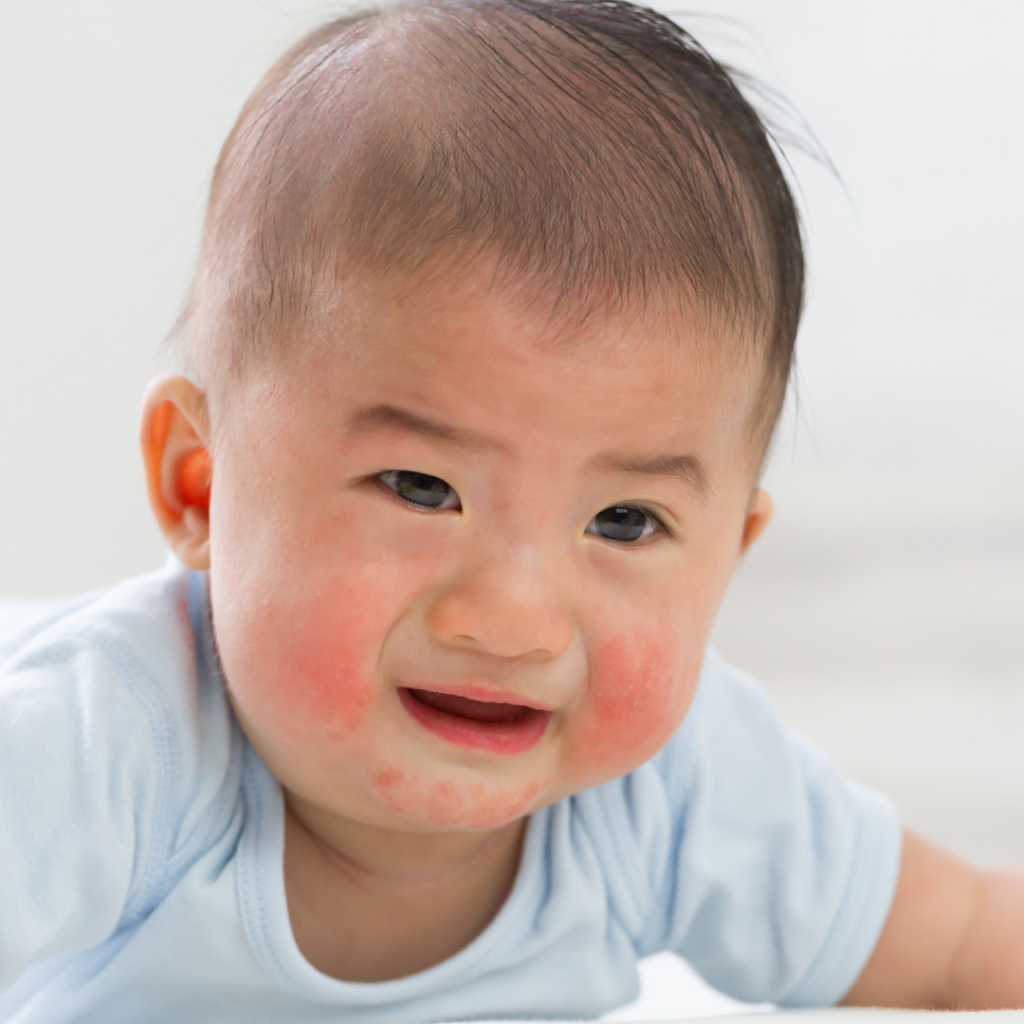
Rice is also considered gluten-free and is generally well-tolerated by those with Celiac disease (22, 23). Always be sure to read the ingredient labels on all food products.
FPIES
Food protein-induced enterocolitis syndrome (FPIES) is a non-IgE-mediated food allergy, meaning no antibodies are produced in reaction to the food (24). Rice is a common trigger for FPIES, in addition to soy, cow’s milk, barley, chicken, turkey, fish, and oats (24).
Symptoms of FPIES generally occur in the gastrointestinal system and include severe vomiting, diarrhea, low energy, weight loss, and dehydration (24). Symptoms may not be immediate and diarrhea and vomiting may not occur until a couple hours after ingesting the food (24).

If you suspect your baby or toddler may have FPIES, consult your baby’s doctor or an allergist for diagnosis and a treatment plan. The treatment of FPIES is to eliminate rice from the diet. Luckily, research shows that most children outgrow FPIES by age 3 or 4 (24).
Rice FAQs
Can rice cause constipation in babies?
One culprit of constipation in babies can be diets that are high in low-fiber foods and refined grains such as white rice. White rice has been processed to have the outer bran layer removed, which is what contains the fiber.
If your baby is experiencing constipation and consumes a lot of white rice or baby rice products, you can try limiting the rice and offering foods higher in fiber such as ….
- Prunes
- Ground chia/flax seed
- Avocado
Is rice easy to digest for babies?
Yes, babies can easily digest rice and starch at around 6 months of age when they’re showing all of the developmental signs of readiness to start solid foods.
You don’t have to avoid starchy foods for your baby. In fact, avoiding starchy foods for your baby greatly limits the variety of foods available for your baby to eat. Rice can be part of a healthy diet for babies when offered in moderation along with a variety of other foods.
Is it safe for babies to eat rice?
From a choking hazard perspective, yes it is safe to eat.
From an arsenic perspective, yes it is safe to eat in moderation. Rice contains varying levels of arsenic, which can be dangerous for babies and young children who are more susceptible to its negative effects.
This is why we always recommend variety, both in the type of rice consumed and in the frequency with which it is included in their diet.
Is brown rice healthier than white rice?
Yes, brown rice is more nutrient-dense than white rice. Brown rice contains fiber and important nutrients like B vitamins, magnesium, phosphorus, and more.
White rice has been processed to remove the outer bran layer that contains many of the nutrients and fiber. Therefore, white rice is less nutritious than brown rice.
However, the high fiber content of brown rice can easily fill up a baby’s stomach, leaving less room for them to consume other nutrient-dense and important foods. Brown rice also has 80% more inorganic arsenic on average than white rice.
So, while brown rice is more nutritious than white rice, it also has more arsenic which we want to be cautious of for babies and young children. We recommend varying the type of rice offered to your baby, and avoiding offering only brown rice because it’s “healthier” and more nutrient-dense.
How do you serve rice cereal to babies?
The texture of rice cereal can be modified based on the amount of liquid added to the rice cereal powder. To achieve a smooth runny texture, add a bit more liquid than the recommended amount (this would be phase 0). To achieve a thicker consistency, add less than the recommended amount of liquid (this would be phase 1).
Serve on a preloaded spoon for your baby to practice using utensils. If your baby isn’t interested in using utensils right away, let them dig in with their hands!
All in all, rice is a great food to offer your baby when starting solids! Keeping in mind our recommendation to serve your baby a variety of ALL foods, rice can be a healthy part of your baby’s diet in moderation and can be a great first food to celebrate the feeding journey for your little eater.
If you’re feeling overwhelmed about starting solids and you’re not sure where to begin, join our FREE workshop – How to start solids: A realistic first week of feeding your baby. This workshop is for parents ready to feel confident and prepared to start solids—without all the guesswork.
Learn exactly what to feed, when to feed it, and how to do it—step-by-step—with expert guidance from pediatric dietitian, Edwena Kennedy. Plus, get a FREE 5 day meal plan just for attending!
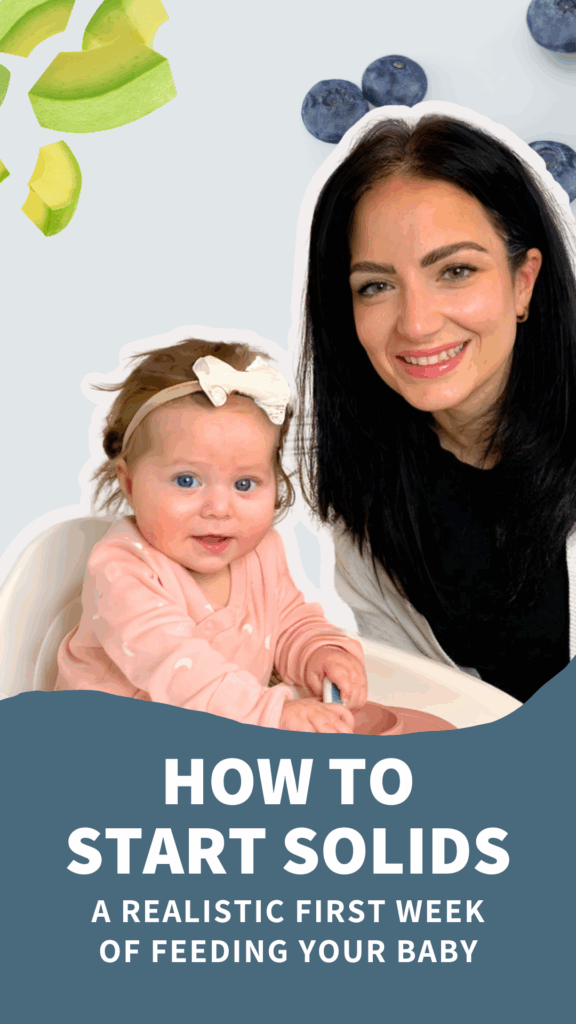
To get instant access to all of the foods in the Texture Timeline™ Food Video Library, along with our signature course for starting solids with evidence-based research and expert guidance, enroll in our Baby Led Feeding Program!
Complete with video lessons, printable resources for everything along the way, and an app to access it all at your fingertips, it’s like having a team of feeding experts in your pocket supporting you every step of the way.
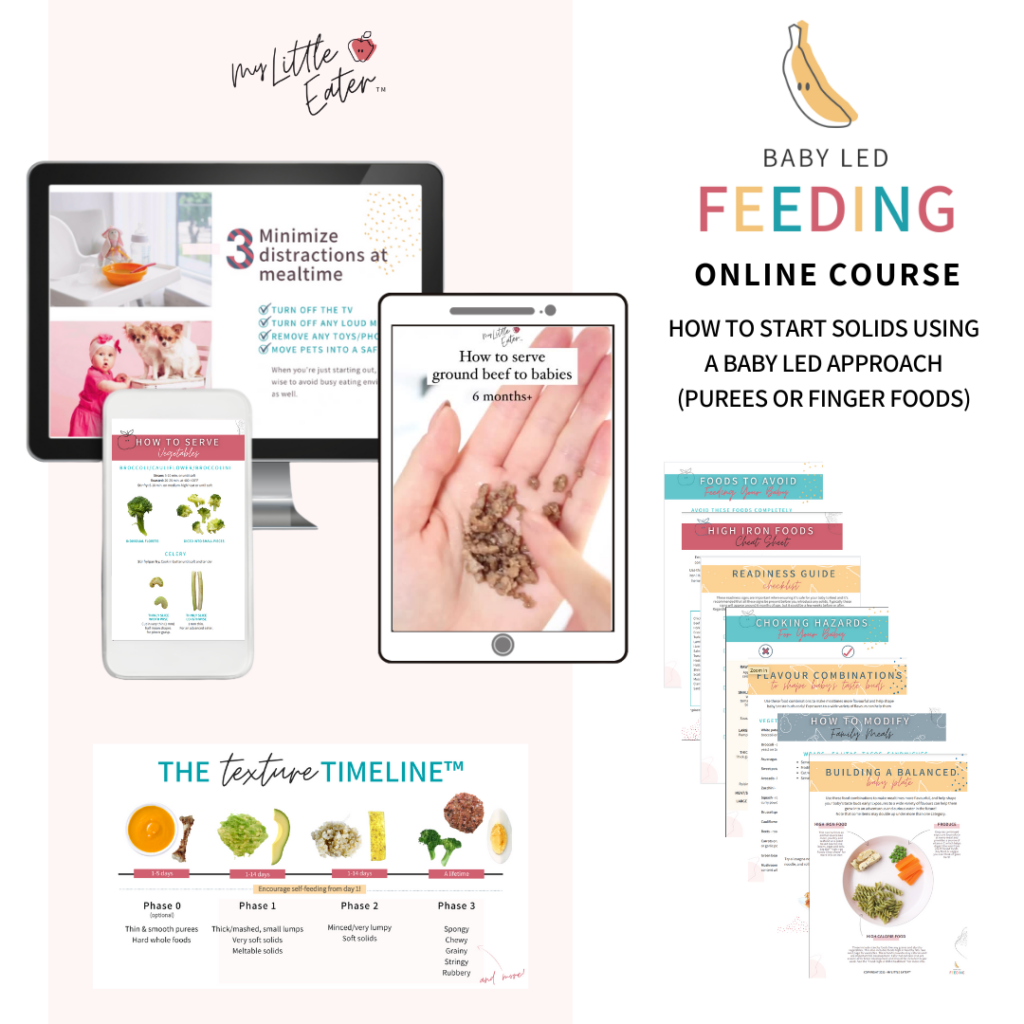
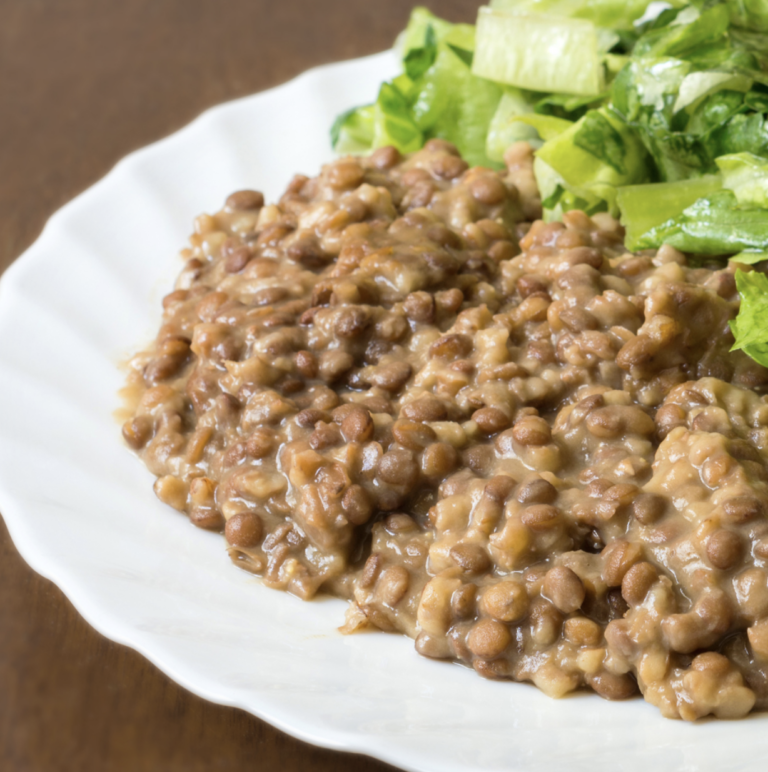
Lebanese Mujadara
Equipment
- 1 large pot
- 1 non-stick pan
- 1 immersion blender
Ingredients
- 5¼ cups brown or green lentils
- 15 cups water (to boil lentils)
- ⅓ cup short-grain rice (uncooked)
- 2 onions (large)
- 2 tbsp olive oil
- 4 tbsp vegetable oil
- 2 tsp ground all spice
- 2 tsp ground cumin
- ½ tsp ground black pepper
- Pinch of salt
Instructions
- Cook the lentils covered on medium-high heat in a large pot of water (about 15 cups) for about 45 minutes or until tender. Stir the lentils every 15 minutes.
- While the lentils are cooking, prepare the caramelized onions. Peel and chop the onions. In a nonstick pan on medium-high heat, add the olive oil and vegetable oil. Add the onions. Once the onions start to brown, turn the heat to medium heat. Slowly cook the onions until they caramelize. Add the rinsed and drained rice. Continue to cook for one to two minutes. Set aside.
- Once the lentils are soft, blend with a hand immersion blender. Turn the heat on low. Add the rice and caramelized onion mixture, stirring every 3 to 5 minutes until the rice is finished (about 30 minutes). Keep the mujadara covered while cooking. The mujadara is finished when the rice is tender and the consistency is like refried beans.
- Season with allspice, ground cumin, black pepper, and salt.
- Serve warm with crispy onions on top for yourself, but avoid serving crispy onions to baby.
Notes
- Depending on the lentils and cooking setup, this recipe may need more water. Adjust as needed.
- Store leftovers in an air-tight container in the fridge for 4-5 days.
- You can freeze mujadara for up to 3 months. To reheat, thaw in the fridge overnight and microwave until heated through.
- You can substitute rice for bulgur.
Pin this info & recipe to save for later!

References
- Linares, O. African rice (Oryza glaberrima): History and future potential. Proceedings of the National Academy of Sciences of the United States of America, 99(25), 16360-16365. doi: 10.1073/pnas.252604599
- Living the Ancestral Way. Oryza Glaberrima – and the decline of Indigenous African Foods. Retrieved from: https://abenaoffehgyimah.com/blog/oryza-glaberrima-and-the-decline-of-indigenous-african-foods
- Centers for Disease Control. Choking hazards. Retrieved from: https://www.cdc.gov/infant-toddler-nutrition/foods-and-drinks/choking-hazards.html?CDC_AAref_Val=https://www.cdc.gov/nutrition/infantandtoddlernutrition/foods-and-drinks/choking-hazards.html
- South China Morning Post. Japan grapples with sticky problem – potentially fatal mochi binge over holidays. Retrieved from: https://www.scmp.com/week-asia/lifestyle-culture/article/3292871/japan-grapples-sticky-problem-potentially-fatal-mochi-binge-over-holidays
- Think Rice U.S. Grown. U.S. Rice Varieties. Retrieved from: https://www.usarice.com/thinkrice/discover-us-rice/us-rice-varieties#:~:text=There%20are%20more%20than%20120%2C000,%2C%20starch%20content%2C%20and%20flavor
- Rice Select. A Foodie’s Guide to Rice Varieties. Retrieved from: https://riceselect.com/blog/a-foodies-guide-to-rice-varieties
- Consumer Reports. How much arsenic is in your rice? Retrieved from: https://www.consumerreports.org/cro/magazine/2015/01/how-much-arsenic-is-in-your-rice/index.htm
- SciTech Daily. Scientists find new way of cooking rice that removes arsenic and retains nutrients. Retrieved from: https://scitechdaily.com/scientists-find-new-way-of-cooking-rice-that-removes-arsenic-and-retains-nutrients/
- Food Standards Agency. Home food fact checker. Retrieved from: https://www.food.gov.uk/safety-hygiene/home-food-fact-checker
- NHS. Children’s food: safety and hygiene. Retrieved from: https://www.nhs.uk/conditions/baby/weaning-and-feeding/childrens-food-safety-and-hygiene/
- Think Rice. U.S. Grown. How to store rice. Retrieved from: https://www.usarice.com/thinkrice/how-to/how-to-store-rice
- The Nutrition Source Havard T.H. Chan. Rice. Retrieved from: https://nutritionsource.hsph.harvard.edu/food-features/rice/
- The Nutrition Source Havard T.H. Chan. Fiber. Retrieved from: https://nutritionsource.hsph.harvard.edu/carbohydrates/fiber/
- The Nutrition Source Havard T.H. Chan. Thiamin – Vitamin B1. Retrieved from: https://nutritionsource.hsph.harvard.edu/vitamin-b1/
- The Nutrition Source Havard T.H. Chan. Vitamin B6. Retrieved from: https://nutritionsource.hsph.harvard.edu/vitamin-b6/
- The Nutrition Source Havard T.H. Chan. Mangesium. Retrieved from: https://nutritionsource.hsph.harvard.edu/magnesium/
- The Nutrition Source Havard T.H. Chan. Phosphorus. Retrieved from: https://nutritionsource.hsph.harvard.edu/phosphorus/
- The Nutrition Source Havard T.H. Chan. Selenium. Retrieved from: https://nutritionsource.hsph.harvard.edu/selenium/
- Cleveland Clinic. 5 Health Benefits of Manganese. Retrieved from: https://health.clevelandclinic.org/manganese-benefits
- The Nutrition Source Havard T.H. Chan. Iron. Retrieved from: https://nutritionsource.hsph.harvard.edu/iron/
- Caring for Kids. Iron needs of babies and children. Retrieved from: https://caringforkids.cps.ca/handouts/healthy-living/iron_needs_of_babies_and_children
- Mayo Clinic Gluten-free diet. Retrieved from: https://www.mayoclinic.org/healthy-lifestyle/nutrition-and-healthy-eating/in-depth/gluten-free-diet/art-20048530
- Johns Hopkins Medicine. Dietary changes for celiac disease. Retrieved from: https://www.hopkinsmedicine.org/health/conditions-and-diseases/celiac-disease/dietary-changes-for-celiac-disease
- American College of Allergy, Asthma, & Immunology. Food Protein-Induced Enterocolitis Syndrome (FPIES). Retrieved from: https://acaai.org/allergies/allergic-conditions/food/food-protein-induced-enterocolitis-syndrome-fpies/
- The Rice Association. History of rice. Retrieved from: https://www.riceassociation.org.uk/history-of-rice
- Amara Organic Foods. Baby food around the world: What baby’s first foods are around the world. Retrieved from: https://amaraorganicfoods.com/blogs/blog/baby-food-around-the-world-what-babys-first-foods-are-around-the-world
- Tiny Mighty Eaters. International first flights of tiny bites. Retrieved from: https://www.tinymightyeaters.com/blog/international-first-flights-of-tiny-bites
- HuffPost. What babies eat around the world. Retrieved from: https://www.huffpost.com/entry/what-babies-eat-around-th_b_4338355

Jillian Smith, RD
Registered Dietitian at My Little Eater Inc., and dog-mom to River. Jillian works behind the scenes answering nutrition questions and supporting parents of babies and toddlers to feed their little ones with confidence.
Click below to book a counselling session with Jill today!

Jillian Smith, RD
Registered Dietitian at My Little Eater Inc., and dog-mom to River. Jillian works behind the scenes answering nutrition questions and supporting parents of babies and toddlers to feed their little ones with confidence.
She offers parents one-on-one support through 30 minute Ask Me Anything sessions, click below to schedule your call!

Bianca Gruenewald, RD
Bianca is a Registered Dietitian and works in a client support role at My Little Eater Inc. She's a proud auntie to her three year old niece and four year old nephew!

Bianca Gruenewald, RD
Bianca is a Registered Dietitian and works in a client support role at My Little Eater Inc. She's a proud auntie to her three year old niece and four year old nephew!
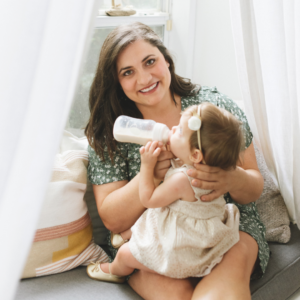
Mallory Roberts, SLP
Mallory is a Speech-Language Pathologist, Infant Feeding Specialist, and Craniosacral Therapist. She's also a busy mom of four little ones!

Mallory Roberts, SLP
Mallory is a Speech-Language Pathologist, Infant Feeding Specialist, and Craniosacral Therapist. She's also a busy mom of four little ones!









